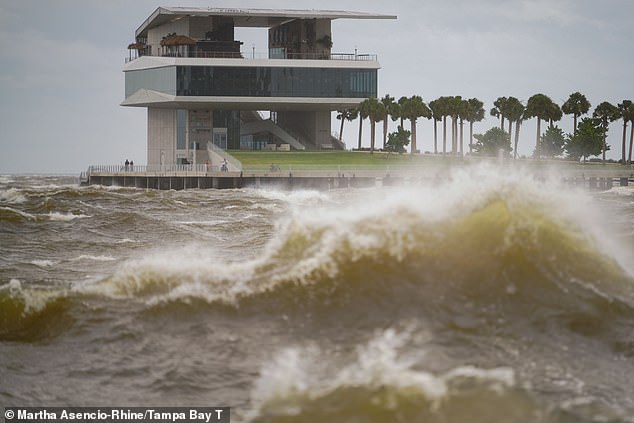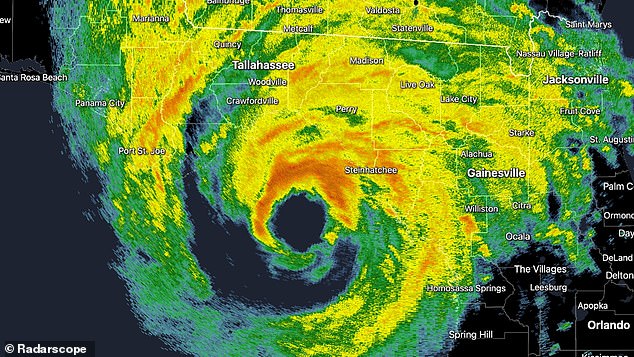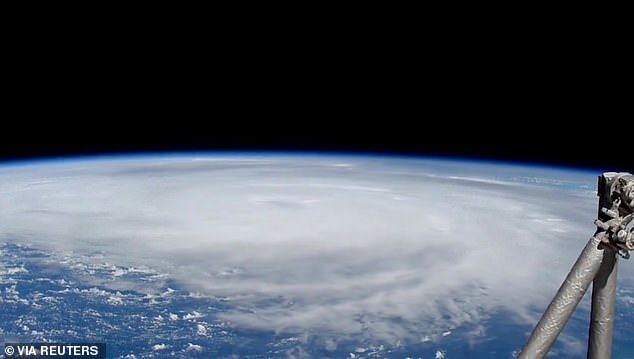What is a storm surge? Destructive weather event described as more deadly than wind intensifies as Hurricane Helene hits the US
As Hurricane Helene hits southeastern America, US authorities have warned that people could drown in their homes if they don’t heed evacuation warnings.
Parts of Florida and Georgia are facing “unsurvivable” conditions due to the risk of “storm surges,” a weather event described as a “wall of water.”
Storm surges as high as 20 feet could hit low-lying coasts, which could be particularly “catastrophic” in Apalachee Bay.
But what exactly is a storm surge and how is it caused?
MailOnline takes a closer look at this ‘devastating’ weather phenomenon that can lead to extensive flooding, property damage and death.
A storm surge is ocean water pushed toward the coast by a hurricane. This ‘devastating’ weather phenomenon is considered more dangerous than wind

This image shows Hurricane Helene on September 26, 2024 at 5:51 PM UTC. Parts of Florida face “unsurvivable” conditions when Hurricane Helene hits later Thursday, the U.S. Weather Service said, warning that howling winds will drive destructive waves and storm surges up to 20 feet high onto the low-lying coast.
Storm surges are caused by hurricanes, known as the strongest storms on Earth.
Hurricanes consist of extremely strong horizontal winds that swirl around a central point.
Hurricanes cause storm surges by whipping up the ocean waters and slamming this huge ‘wall of water’ up to six meters high towards the coast.
Dr. Alison Cobb, a hurricane expert at Imperial College London’s physics department, said a storm surge is a “complex” event that can cause “devastating flooding.”
“During storm surges, coastal waters are pushed towards the coast by the force of high winds, causing them to rise abnormally high,” she said.
Scientists consider storm surges more dangerous and deadly than winds simply because they are more powerful and can cause more damage.
‘It comes down to the simple fact that water is much denser than air – about 830 times more dense,’ Ivan Haigh, professor of ocean and earth sciences at the University of Southampton, told MailOnline.
‘Because water is more dense than air, it causes more damage to buildings and infrastructure.’

The St. Pete Pier is pictured among high winds and waves as Hurricane Helene makes its way toward the Florida Panhandle, west of Tampa Bay, September 26, 2024

Hurricane Helene explodes into a Category 4 monster as terrifying radar image shows its lightning-filled eyes streaking toward Florida

People are splashed by the swirling surf from Tampa Bay as Hurricane Helene passes offshore in St. Petersburg, Florida on September 26, 2024. Storm surges are significantly higher and cause more damage
Storm surges can push buildings off their foundations, trap and drown people in their homes, and wash away roads and bridges.
Of course, hurricanes do their own share of damage, usually by ripping off roofs, toppling trees and snapping power lines.
But in general, homes provide more protection from hurricanes than from storm surges, making evacuation warnings common.
“While the impact of wind and rain is widespread, the impact of storm surge is potentially the most threatening,” Dr Cobb said.
‘Early warning and evacuation plans will hopefully save many lives, although damage to homes and communities will continue for many months to come.’

This satellite image shows Hurricane Helene barreling through the Gulf of Florida, September 26, 2024
If a storm surge hits the coast, its exact height will depend on the depth of the continental shelf – the edge of a continent that lies beneath the ocean.
In general, the shallower the continental shelf, the higher the storm surge, because the wave has less room to spread.
When Hurricane Katrina approached the US coast in 2005, it caused a storm surge of more than 8 meters in some areas.
This led to widespread flooding, including almost the entire city of New Orleans, where the seawall could not cope with the water levels.
Hurricane Katrina killed more than 1,800 people in the US, many of them from flooding caused by the storm surge.
There can also be a ‘negative storm surge’, where the wind direction blows the water away from the coast, causing the sea level there to drop.
Met Office explains: ‘These are less dangerous than positive storm surges as they do not pose a risk of flooding.
“But they can damage ships in port and leave them stranded until the water level rises again.”
